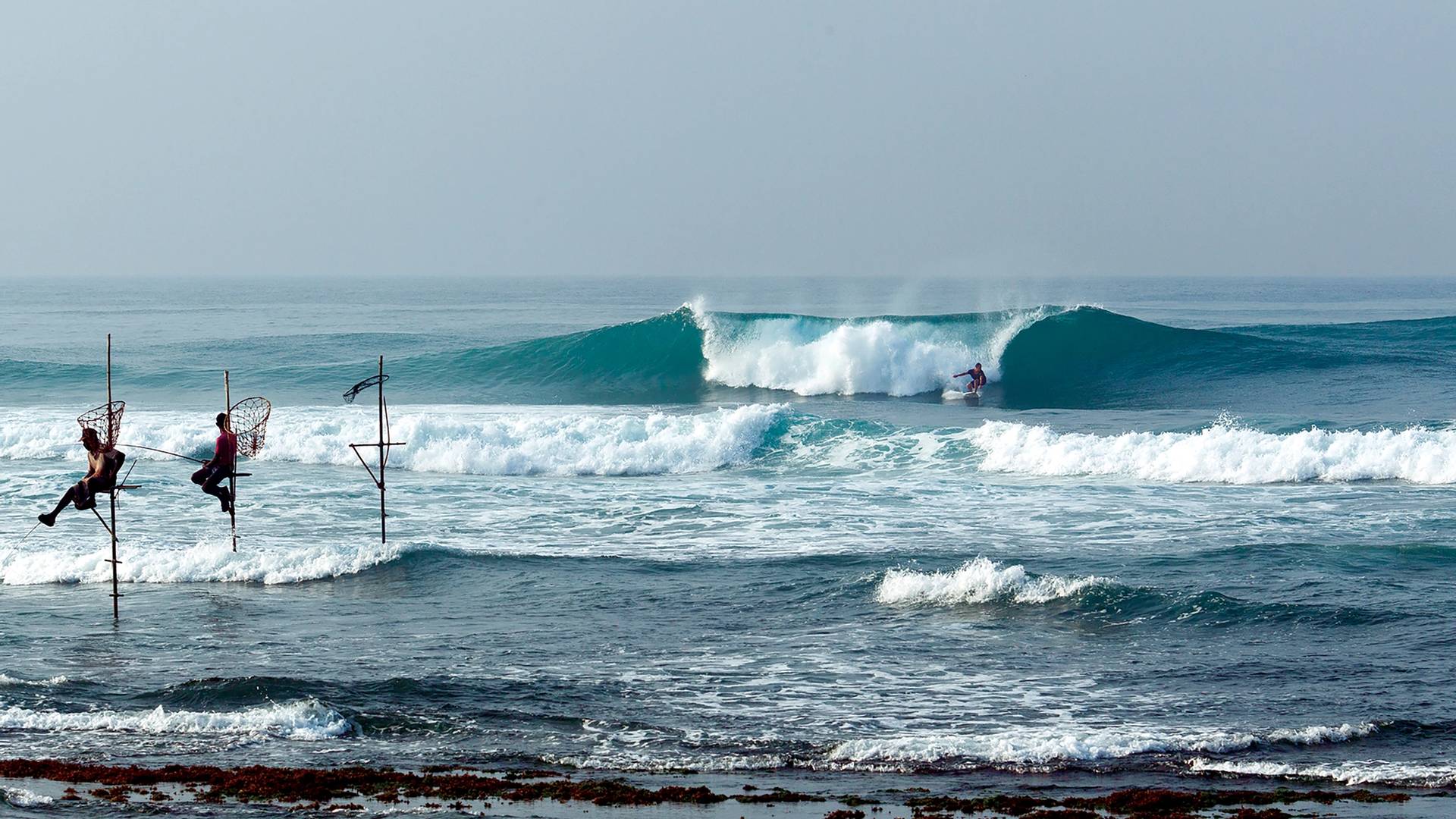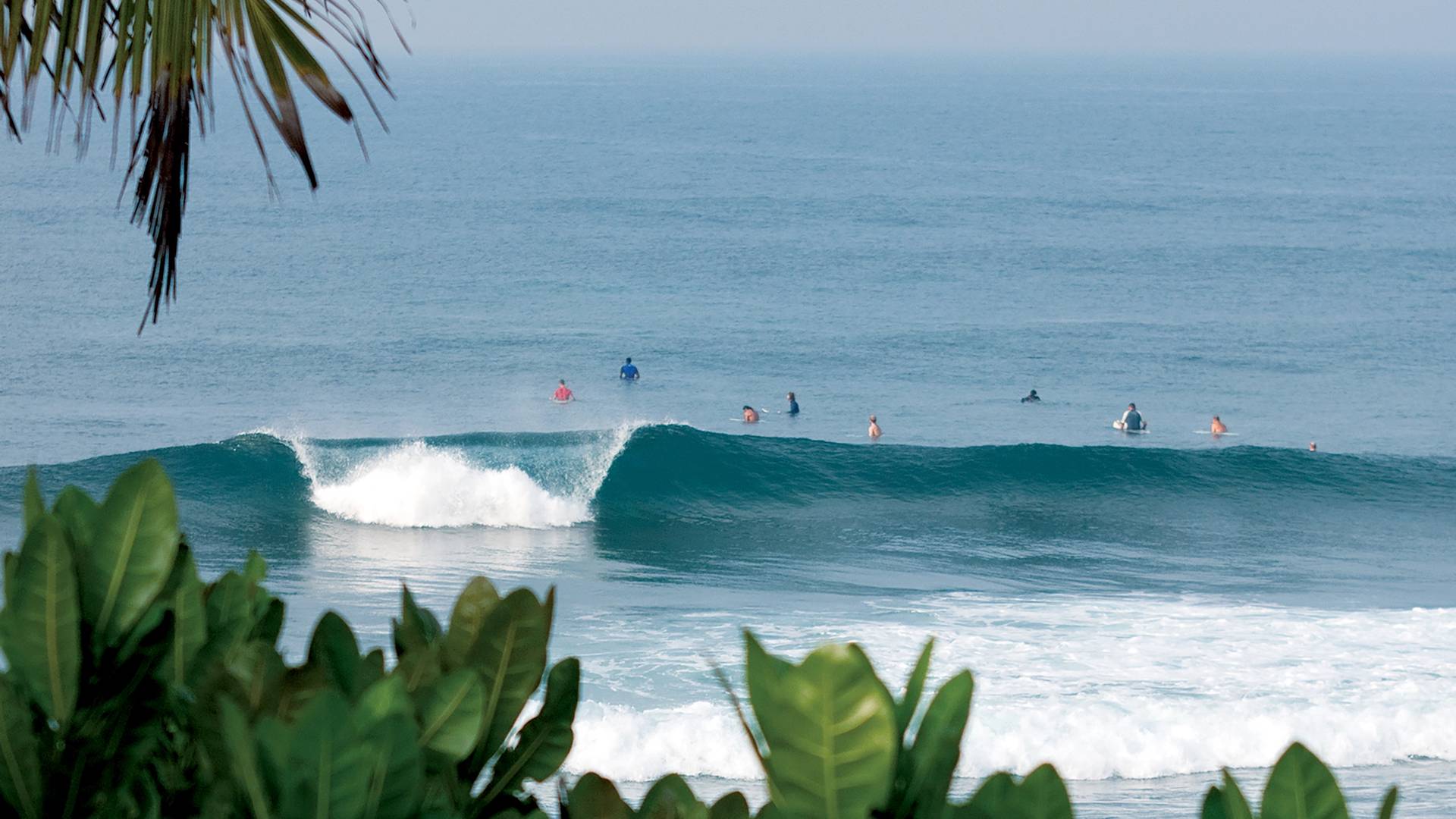Sri Lanka
Country Data
Regions
2
Breaks
45
Coastline
1,340 KM
Cost of living
Capital
Colombo/Sri Jayawardenepura Kotte
Current Time
Security
Health
Where to surf in Sri Lanka
The teardrop-shaped island falling from the southern tip of India, is the best-known and busiest surf destination on the Subcontinent. Sri Lanka divides the Arabian Sea from the Bay of Bengal. Famed for a warm welcome and laid-back atmosphere, this ancient culture is blessed with superb temples, rich wildlife, Ayurvedic massages, and some great tropical surf.
Sri Lanka has had its fair share of difficulties including the brutal civil war from 1983 to 2009, which put a dampener on tourism and development, but didn't stop some surfers from enjoying the lower crowd factor that comes with political instability. Then came the Boxing Day tsunami on 26th December 2004, when three waves, estimated to be 45ft (13m) high, struck the island with apocalyptic force, flattening villages, beachside hotels and destroying 80% of Sri Lanka’s entire fishing fleet. Up to 35,000 people perished across the country, compared to 100,000 killed and 20,000 missing in the 26yr war. Recent troubles include the Easter 2019 Islamic terrorist suicide bombings of churches and hotels claiming 269 lives, plus the 2022 social unrest against the corrupt government who have mismanaged the economy, Covid 19 and brought hyper inflation, along with power cuts and fuel shortages across the country.
Southwest Sri Lanka
There is plenty of empty, soft beach and reefbreak along the west coast, both north and south of Colombo, but it’s tiny during the NE monsoon. Wave size doubles by mid July, but the westerly winds usually put paid to any decent shape and only the kiteboarders will be having fun over coral and sandstone reefs up north at Kandakuliya. Towns like Bentota and Wadduwa have shifting peaks in calm wind conditions, while other stretches of coast are armoured with breakwalls and jetties. Bentota has a number of surf schools catering to the luxury hotels that are clustered around the rivermouth there.
The Southwest Sri Lanka region starts in Hikkaduwa, which used to be the travelling surfer's focus throughout the '80s and '90s. Nowadays more people surf the waves further south around Weligama, where there is a lot more variety and choice, particularly for the beginner/improver brigade whose numbers dominate most of the softer waves. There are a few powerful spots sprinkled about to keep advanced surfers happy during the surf season that runs from October-April, coinciding with the NE monsoon. Due to its popularity, this region continues to expand eastwards past the southern tip of the island at Dondra to the increasingly popular bay at Hiriketiya near Dickwella.
South Sri Lanka
A lot of south coast spots face seasonal limbo, some working in big swell and W-NW winds, while others need the NE winds of winter. Much of the beachbreak is shoredump most of the time, but there are a lot of rocky coves that can transform unruly swells into something worth searching for. East of Hiriketiya, the last break in the Southwest Sri Lanka region, the coast begins to bend northwards away from the prevailing swell, so wave heights will drop, yet this is ideal for beginners at the many sandy beaches. This also means during the SW monsoon, beaches that face SE could provide some protection from the wind and hold off-season waves at the deeper bays. Check between Nilwella and Kudawella harbours for easy beachbreak, or head towards Tangalle where there is a righthand pointbreak at Unakuruwa. Extensive sandy beaches featuring endless shoredump dominate from Tangalle to Hambantota, where the main city beaches are poor quality and the rocky points flawed. Kirinda has some scrappy beachbreak between the granite and sandstone outcrops and Palatupana is a sketchy right point inside the massive wilderness of the Yala National Park. Yala Rights have been surfed, but only by boat from Kumana and the large rivermouth means large mugger crocodiles!
Southeast Sri Lanka
Once the monsoon winds switch and start blowing from the SW-W, attention switches to Southeast Sri Lanka, where experienced surfers will revel in the delights of Arugam Bay and learners can surf softer, sand-bottomed waves at a number of spots. This coast is far less-developed, with no coastal high-rise hotels, far fewer tourists and a simpler, laid-back vibe. The surf zone also sits on the edge of a network of large national parks, where the variety of wildlife you can see on a short safari is truly world-class.
It is not recommended to travel too far up the northeast coast. Not because the recently ended civil war has ravaged this region for decades, but because it's basically one featureless and continuous beachbreak. It is also size deficient most of the time and aside from a few scallops holding up the odd right and onshore slop in the NE monsoon, there is little reason to go up the coast, other than to escape the large groups of foreign surfers who regularly descend on Arugam Bay, often to hold their own national surfing contests.
Sri Lanka surf map
Explore the 2 regions & 45 surf breaks in Sri Lanka.
Travel Information
General
- Current Time
- Tourists
- 2,334,000
- Population
- 21,413,249
- Tourist Info
- Tourist Info
Security
Health
Money
- Currency
- LKR
- Exchange rate
- $1 = 108.75 LKR LKR
Cost of living
Communication
- Dialing in
- +94
- Dialing out
- 00
- Emergencies
- 112 (police), 110 (ambulance and fire)
- Language
- Sinhalese and Tamil (both Official), English is widely used in tourist areas.
Electricity
- Plug Type
- dgm
Visas
It is best to get your Electronic Travel Authorisation Visa (ETA) prior to arrival (US$36). For some nationalities it can be obtained on arrival, but to avoid time and hassle do it before. In 2019 Sri Lanka trialed some visa free travel, but a bombing and Covid put this on hold. Check the latest news before booking a trip.
Due to global pandemic, Visas, Getting There, Getting Around or Accommodation information and pricing may have changed. Always check Government Travel Advice before travelling.
Travel Gallery
Library
Helpful surf travel videos and articles featuring Sri Lanka.
The Stormrider Passport
Get your Stormrider Passport to explore 5000 surf spots for as little as £1.25 a month.
What’s in it for you?
- 01.
5,000 DETAILED BREAK REPORTS
Access to 5,000 detailed surf spot descriptions with ability to save spots for offline access.
- 02.
10 STORMRIDER ICONS FOR EVERY SPOT
Compare our iconic, easily recognisable symbols, highlighting 10 crucial factors for every surf break.
- 03.
UNIQUE STORMRIDER FILTERS
Personalise your search by matching your skill level, travel plans, and seasonal preferences to discover your perfect waves.
- 04.
WINDY FORECAST FOR EVERY BREAK
Get the latest surf conditions from our forecast partners at Windy, plus webcams and forecasting links.
- 05.
COMPARE REGIONAL SURF SPOT DATA
Compare regional break data and statistics to quickly discover your ideal surf destinations.
- 06.
CREATE YOUR PERSONAL WORLD SURF MAP
Easily build a map of your worldwide surf travel adventures, or create a bucket list of future destinations.

We've got more in the pipeline
Signing up not only gives you access to the World’s best surf information, it allows us to create even more amazing features in the future.






















